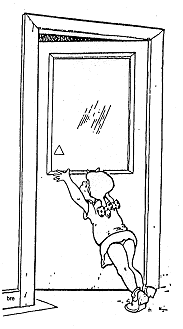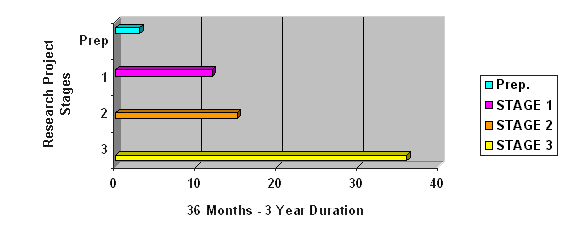European
Fire Research Project
2000-2004
(under the auspices of the EuCAN
Expert Group Network - Luxembourg)
| Accessibility
for Everyone ? |
 |
....... Evacuation
for Some ! |
|
| People
with Activity Limitations |
| Protection
from Fire in Buildings |
Wider Context for this
Research Project
Disability
Rights & Removing Physical Restrictions on Participation
in Society
Protection
of Historical Buildings & Archives from Fire
Structural
Design for Fire afer the WTC (9-11) Incident ?
Design
Concepts & Principles for Protection from Fire in
Buildings
Project Aims :
| a) |
To elaborate
(and, if possible, to validate in 'real' situations)
principles of practical fire safety design / engineering,
management and firefighting / rescue for New
Buildings, which adequately incorporate a proper
consideration of the health protection of People
with Activity Limitations in a fire situation ;
|
| b) |
To examine
how the principles identified in a) above may best
be applied to Existing Buildings of historical,
cultural or architectural importance, within a context
of proper conservation, i.e. minimum impact on building
structure and fabric consistent with the Venice
Charter - while achieving the desired / required
level of fire safety ;
|
| c) |
To make recommendations
with regard to the Building Design Process,
and to the Roles of Building Managers, Rescue
Teams, Firefighters, other First Responder Personnel,
and particularly People with Activity Limitations
themselves, at the scene of a fire - but also in the
context of fire prevention, fire drills, etc ;
|
| d) |
To establish
a multi-disciplinary and cross-sectoral Network
of individuals and/or representative organizations
in each participating country, whose active interest,
involvement or work relates to the issues of ........
- protection of people with activity
limitations in the event of fire ;
- accessibility of buildings and
the 'built environment' ;
|
| e) |
To encourage
and promote a method of working in this Network, which
facilitates a Wide Dissemination of available
knowledge and expertise concerning fire prevention
and protection measures / devices / innovative technologies
related to the issues specified in a) to c)
above ;
|
| f) |
To produce a Harmonized
E.U. Vocabulary (in English, Italian, Swedish,
French and Flemish) , which focuses on People with
Activity Limitations, but which also coherently
amalgamates the following subject areas ........
- fire safety design / engineering
of buildings, and related urban planning issues;
- fire protection in buildings
;
- building related firefighting
and rescue ;
- building management ;
- environmental impact.
|
| g) |
To produce a simplified
Harmonized E.U. Classification of Activity Limitations,
for the purposes of protection from fire in buildings,
which is based on the World Health Organization's
2001 International Classification of Functioning,
Disability and Health (ICF). People have varying abilities
in relation to self-protection during any emergency
- those concerned should be aware of these variations,
and the probable user profiles and numbers involved
at the scene of a fire. |
| h) |
Through the Networks in
the different participating countries, to formulate
answers to practical, everyday problems associated
with the protection of People with Activity Limitations
from fire in buildings ; |
| i) |
To produce an E.U. Technical
Guidance Document which will have widespread application
across Europe. |
Project Core Partners & National Contacts :
| Belgium |
Major Franklin De
Herdt, Senior Fire Officer
Service d'Incendie et d'Aide Medicale Urgente de
la Region de Bruxelles-Capitale,
Avenue de l'Helliport 15,
B-1000 Bruxelles,
Belgium .
e-mail
: fdeherdt@firebru.irisnet.be
|
| Italy |
Ms. Mitzi Bollani, Architect
Via Vitali 3,
I-29100 Piacenza,
Italy.
e-mail
: bollani@tin.it
internet
: www.bollani.com
|
| Ireland |
Mr. C. J. Walsh, Architect,
Fire Engineer & Technical Controller
FireOx International,
51 Auburn Hill,
Aughrim Street,
Dublin 7,
Ireland .
e-mail
: cjwalsh@sustainable-design.ie
internet
: www.fireox-international.com
|
| Sweden |
Ms. Elena Sire, Architect
& Researcher
KTH - Royal Institute of Technology,
Department of Architecture & Town Planning,
Building Function Analysis,
S-100 44 Stockholm,
Sweden.
e-mail
: elena@arch.kth.se
internet
: www.elenasire.se
|
If you
wish to Participate in this Research Project, or make
a Submission
Please contact the Research
Project Leader C
J Walsh
Target Fire Safety Objective
:
During and after the process of independent evacuation
to a 'place of safety' which is distant from the
building , or partial evacuation to a 'place of relative
safety' within the building, or protection in place,
the individual Health, Safety and Welfare of those people
involved, including firefighters, should be assured.
Method
of Working, End Product & Dissemination :
The Project will initially
establish a working network at national level in each
country, which is multi-disciplinary and cross-sectoral.
Direct involvement of people with activity limitations
will be a requirement.
Principles of practical building design / engineering,
management, and firefighting / rescue will be developed
which must measurably improve the general level of fire
safety and protection for people with activity limitations,
through the informed use of appropriate performance indicators,
and benchmarking. These principles will then be validated
by demonstration in 'real' construction situations and
by monitoring of actual performance.
Multi-disciplinary work will
progress at national levels, but also at European level
in Clusters .....
- Fire Safety Design / Engineering of
Buildings ;
- new buildings
- buildings of historical, cultural
or architectural importance
- Firefighting and Rescue from Buildings
;
- carrying and aid techniques
- Building Management ;
- classification of activity limitations
-
Self-Defence for People with Activity Limitations ;
This
Cluster will concentrate on the psychological and physical
aspects of people with activity limitations providing
their own personal protection and performing specific
fire safety duties. Also
- meaningful consultation with the
various actors
- carrying and aid techniques
- classification of activity limitations.
Typical
end users of the research results generated will be Consumers,
Policy and Decision Makers, Individual Building Clients
and Client Organizations, Architects, Fire Protection/Safety
Engineers, Fire Service Personnel, Building Managers, Personnel
in AHJ's, Control and Regulatory Authorities, Developers,
and Building Contractors, etc.
Finally,
a Technical Guidance Document will be produced
for wide dissemination at local, regional, national, and
E.U. levels.
Relevant
Directorates-General in the European Commission
will be kept informed of progress in the Project.
Every
six months, progress will also be reported to meetings
of the EUropean
Concept for Accessibility Network (EuCAN) - a
Pan-European Group of Technical Experts co-ordinated from
Luxembourg.
Project
Stages :

| Stage
1 : |
Establishment
of a multi-disciplinary, cross-sectoral European
Network ;
|
| Stage 2
: |
Development
of Fire Safety Design / Engineering, Management
& Firefighting / Rescue Principles ;
|
| Stage 3
: |
Validation
of Stage 2 Principles, and Production of a Technical
Guidance Document , with related Performance
Indicators .
|
First
Meeting of the Network in Belgium :
This
meeting took place on Friday, 20th October 2000 - in Brussels,
Belgium - at the Headquarters of the Brussels Fire Service.
| Agenda |
| 09.00
- 09.30 |
Welcome,
Introductions, Expectations
|
| 09.30
- 10.30 |
Presentation
and Discussion of the Research Project
|
| 10.30
- 11.00 |
Coffee
|
| 11.00
- 12.00 |
Project
Participation, Method of Working, Cluster Tasks, Network
Tasks, End Product, Time Scales, Real Building Validation,
Project Co-Ordination, Communication, Meetings, Funding,
Co-Ordination with Other Organizations, Dissemination
|
| 12.00
- 12.30 |
Discussion
|
| 12.30
- 14.00 |
Lunch
|
| 14.00
- 15.30 |
Cluster
Meetings
|
| 15.30
- 16.00 |
Coffee
|
| 16.00
- 17.00 |
Plenary
Discussion, Programme of Work, Tasks between Meetings
Next Two Meetings - Date, Venue, Times
|
| 17.00 |
Farewell
|
Documentation
considered at the meeting ........
-
WHO International Classification of Functioning &
Disability (ICIDH-2) ;
-
Vocabulary
- 'Fire Safety & Protection in Buildings' ;
-
Vocabulary
- 'Disability'.
Seminar
& Workshop in Italy - February 2001 :
In
the work of the Italian Network, focus is being directed
at Health Facilities, i.e. an establishment, or any unit
of an establishment, which provides health care. The
far greater part of this building stock is historical.
Click thumbnails to view Programmes ....
Developments in Ireland :
In the work of the Irish Network, emphasis is being placed
on mental, cognitive and psychological impairment.
|
November
2001 - |
Preparations
for the drafting of the European Technical Guidance
Document (E-TGD) commenced. |
January 2002 - Evacuation Exercise in a Dublin
Shopping Centre.
Click thumbnails
to view larger images ....
Sweden
:
In the work of the Swedish Network, focus is being directed
at Buildings of Historical, Cultural and Architectural Importance.
May 2002 - National Research Project Description
Click
Here to Download PDF
(PDF File, 73kb)
October
2002 - Fire Seminar in Stockholm, Sweden.
Fire Seminar Agenda
Click
Here to Download PDF
(PDF File, 181kb)
Friday Morning, 4th October 2002 - Presentation by CJ
Walsh
Click
Here to Download PDF
(PDF File, 3.01Mb)
WebSites
of Related Interest
European
Lift Association
Sound
Alert Technology (GB) - Directional Sound Evacuation
Directional
Sound Evacuation in Ships

|
You will need
Adobe Acrobat Reader to view the PDF files. Accessibility
of PDF for people with disabilities |
|
